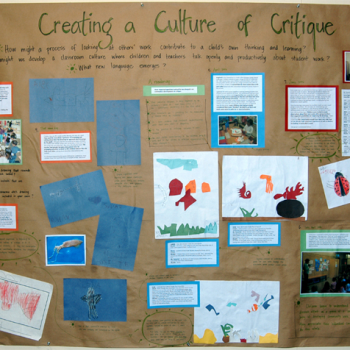
Examples of documentation shared back with learners
PUBLISHED:Resource Summary
Making visible images of learning and being together in a group is a way to foster group identity and learning. This type of documentation promotes conversation or deepens understanding about one or more aspects of a learning experience. It can serve as a memory of learning in the classroom, allowing children and adults to reflect on, evaluate, and build on their previous work and ideas. Sharing documentation back with learners can take many forms: a photocopied sheet of paper, words repeated back to students, work brought back to a small group or put up on a wall, or a carefully arranged panel. The examples in this section range from more immediate and "in the moment" to more fully framed and shaped.
Creating a Culture of Critique
School: Edward Devotion School, Brookline, MA
Documentation by Melissa Tonachel
This piece uses children's observational drawings and conversations to explore how children look at their own and each other's work over time. Kindergartners develop a culture of critique through a shared vocabulary and structures for offering feedback.
Melissa Tonachel uses bold text throughout this piece to indicate her intentions and show where she is interpreting and using her analysis to guide the learning process.
To see the documentation from this example, download the PDF under resource links.
Making Every Voice Heard
School: Cambridge Rindge and Latin High School
Documentation by Jennifer Hogue
As part of a discussion panel on documentation at the 2004 MLV Summer Institute, Jennifer Hogue, a 9th/10th grade English Literature teacher at Cambridge Rindge and Latin High School in Cambridge, presented her account of learning to use documentation to support the learning of older students and her own goal of inviting everyone's voice into the classroom.
Jennifer used documentation throughout a perennial unit she teaches on The Lord of the Flies to build trust, facilitate the sharing of ideas, and ultimately achieve a deeper understanding of the book's content. A transcript from Jennifer's presentation at the Institute and related images from her classroom follows:
"When I first started to use documentation in my classroom, my primary goal was to try to make sure that every voice in the classroom was heard. My first real foray into documenting all these voices culminated in a weekend when I spent at least eight hours going through all of the documentation I had gathered--photographs, quotes, copies of student work, etc.--and, using every ink cartridge, marker, and piece of construction paper I owned, pulled it all together in some lovely posters. I learned a lot of things doing this, but the main thing that I learned was that I wasn't going to spend another weekend like that again in the near future. So I asked myself, "What are some simpler ways that I can try to get at this goal?"
To see the documentation from this example, download the PDF under resource links.
Listening: The Heart of What Documentation Really Is
School: Monument High School
Documentation by Lindy Johnson/Making Learning Visible Team
During a panel on documentation at the 2004 MLV Summer Institute, Lindy Johnson, a 9th grade English Language Arts teacher at Monument High School in South Boston, presented her account of learning to use documentation in ways that were meaningful to her and her students. A transcript and still images from Lindy's presentation at the Institute can be found to the right.
To see the transcript from this example, download the PDF under resource links.

-
-
-
-
-
-
Support PZ's Reach